Category: Reporting
MobileDash Recap
Our MobileDash system has been around for a couple of years now but there are still some of our customers that have yet to experience it.
MobileDash allows you to receive hourly sales updates through email on your phone, tablet or desktop. These updates are sent directly from the store to you. Your employees at the store level don’t even need to know that you can receive this reporting. That helps you stay on top of things.
New to 2012 is a column that shows the report from the last hour reported on. See the example below for some details.
Remember that MobileDash comes with MobileAlerts as well. MobileAlerts provides you with:
Notification on employee clock in.
Alerts if a ticket is voided.
Alerts if a no sale is performed.
Audit reports if an employee attempts to alter a previous ticket.
By the way, call us for a free 45 day trial of MobileDash if you are not already using it!
Posted in Reporting Tagged with: mobiledash, reporting
Cash Accountability and Your POS
Recently I was talking to a client that is opening a new store. One of their concerns was on how to keep the cash sorted out with their employees. It is a great question and one that is answered differently for every store. I’ll try and hit the highlights on methods that SP-1 can use to help you stay on top of it.
First we need to know the different areas where employees handle cash.
Two of them, delivery drivers and servers (think table service) are easily accounted for because you will most likely have them carry a bank. When using server / drive banking, the cash accountability issue is pretty easy. These employees will simply cash out and match up against the server or driver close out report.
It gets more difficult when we talk about the counter service aspect of the store. If you want to help insure accurate tills, follow some of these steps:
- Assign employees to cash drawers. This locks down the cash to only the employee assigned.
- Use Employee Swipe Cards instead of codes and passwords. It is far more secure.
- Use Fingerprint ID instead of Employee Swipe Cards. It is the most secure.
- Buy an extra insert for the cash drawer (with or without a locking lid). That way you can quickly handle shift changes with minimum disruption.
- Buy multiple cash drawers. Employee one is assigned to drawer one and employee two is assigned to drawer two. If they are short, you know where to go.
- Don’t leave the key in the drawer!
- Integrate your credit cards with the POS – that way you don’t have cash / credit discrepencies.
Posted in Reporting Tagged with: cash drawer, reporting
MobileAlerts & Theft control
Are you using our MobileDash feature? If so, you have probably started to use the MobileAlerts feature as well.
One of the key parts of the MobileAlerts is the void and audit tracking. I thought it would be fun to explore this further in a blog. Note that all of the void and edited ticket examples assume that the employee has the security to actually perform the action. If you lock them out, then there is no way for them to even do this.
The first example and scenario is that an employee completed a ticket and then re-opened it and voided that same ticket. In this example, we see that the ticekt was re-opened at 10:44am by John Smith on workstation one. The ticket was then voided by John as well. We can see that they voided the entire ticket, that it originally had 13 line items (not menu items) and that the price was originally $9.24.
Date: 1/25/12 Time:10:44a
Ticket:0004 Carry-Out (VOIDED)
Void: 10:44a 9999 SMITH, JOHN WS:1
Re-Opened: 10:44a 9999 SMITH, JOHN WS:1
Items: Current:0 Original:13
SubTotal: Current: Original: 9.24
Tax: Current: Original:
Total: Current: Original:
This next example shows an employee that has re-opened a ticket and then deleted an item off. John Smith re-opened the ticket and reduced the total sales amount at 10:43 on workstation one. The original ticket had 16 items and a total balance of $10.71. After the reduction, the ticket has 7 items and $5.48 as the total balance.
Date: 1/25/12 Time:10:43a
Ticket:0003 Carry-Out
Reduction: 10:43a 9999 SMITH, JOHN WS:1
Re-Opened: 10:43a 9999 SMITH, JOHN WS:1
Items: Current:7 Original:16
SubTotal: Current: 5.00 Original: 9.75
Tax: Current: .48 Original: .96
Total: Current: 5.48 Original: 10.71
This final example shows that the employee has changed the price of an item (most likely through size). John Smith (boy ,he is a troublemaker) opened the ticket at 10:43 on workstation one and changed something that resulted in the price dropping from $10.10 to $9.28. The number of items (14) stayed the same so we know that he either deleted an item and replaced it with a lower cost item or changed the item directly to a lower cost item.
Date: 1/25/12 Time:10:43a
Ticket:0002 Carry-Out
Reduction: 10:43a 9999 SMITH, JOHN WS:1
Re-Opened: 10:43a 9999 SMITH, JOHN WS:1
Items: Current:14 Original:14
SubTotal: Current: 8.45 Original: 9.20
Tax: Current: .83 Original: .90
Total: Current: 9.28 Original: 10.10
So there you have it. Three ways to read the MobileAlert information coming to your cell phone!
Posted in Order Entry, Reporting, theft Tagged with: employee, mobile alerts, reporting, Theft
Track your costs with inventory control
Want to have a better understanding of where your money is going?
Take a look at integrating inventory control with SP-1. This is a powerful option that allows you to really see the details of what is happening in your store. Our inventory control system is incredibly flexible. We start by tracking an ideal COGS (cost of goods sold) and then reporting that to you whenever you run a business summary. If you are using MobileDash , you will see the COGS hourly automatically as well. This gives you the ability to stay on top of where your numbers are as well as plan for the future. If you combine the COGS with our default Labor Percentage, you will have a very good picture of what your overall costs are.
The next step is to see where your waste or variance numbers are at. Because SP-1 knows how you purchase, inventory and use an item, you can pull a report that shows where your product is going.
Now this is where some of the real power comes into play. This ability will show you what your actual usage verses your ideal usage is. For example, let’s say you have an item that you use by the ounce. If you are performing your inventories, SP-1 can tell you that you should have used 10 of this item but you actually used 15. That means you have a 5 ounce variance. We then go a step further and show you the cost on those 5 ounces that are missing. This is all calculated by the item, sub category and category as well.
The last are of inventory control that SP-1 can help with is with the portion control in the store. Because you can put the amount that should be used to make the item into the system, SP-1 can print, for your kitchen staff, the exact portions of each item that is made!
Posted in POS Features, Reporting Tagged with: inventory
Different ways to handle sales tax.
People are sometimes confused by the different methods of collecting tax in SP-1. SP-1 is capable of handling five different tax rates with in our standard (non-Canadian) version. We then setup the taxable items in the Menu Group file. As a reminder, Menu Groups are main categories. For example, Coffee, Tea, Pizza, Sandwich, Beverages etc.
In the menu group, you can distinguish further by having a different taxable rates by the order type. Each Menu Group can have a different rate for Carry Out, Dine In, Pick up and Delivery. For example. You might have 8.5% for carry out coffee and 9.5% for dine in coffee etc. There is also the ability to set a Menu Group to the 0 tax rate. That will indicate that this is a non-taxed item. This is different than a tax exempt sale however.
Tax exempt sales happen when you sell an item that is usually taxed to a customer that does not pay sales tax. This is handled by creating a customer record and then setting the taxable switch for that customer to non-taxable.
Not to take this too far but we also have the ability to handle the GST / PST tax rates in Canada. Lastly, we handle a VAT (Value Added Tax) ability and the ability to add a PIF (public improvement fee).
Any questions? Just let us know!
Posted in Order Entry, POS Features, Reporting Tagged with: non-taxable, taxes
Get ready for the holidays!
The holiday season is on us and it’s time to start looking at what happened around this time last year!
We know that sales can change around this time of the year. We see different drinks on the menu, seasonal food and a variety of items that are only served this time of year.
With SP-1 we want you to be able to know what happened last year so you can make good decisions as to what to carry this year. Fortunately, we have a number of ways to help you with this.
First we can use our Business Summary Report to see what the sales of specific items were last year. Remember that you can run the Business Summary for any time frame – just enter a starting and ending dates.
The Business Summary is made up of a ton of sub-reports.
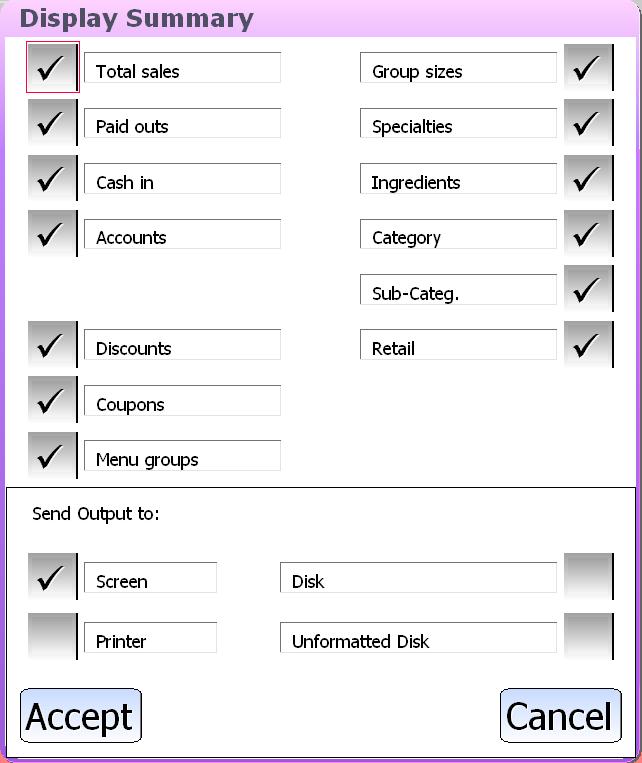
One of the first things to look at is what promotions you ran over the holidays and how they did. The discount or coupon report is great for this.
With this part of the report you can see each discount, how much was discounted off the price, the total number of times it was used and how popular it was compared to your other discounts.
We can then use this to see what the effective discounts were for that time frame and re-run them.
There is one other area we can look at to determine what happened last year. The information below is a sample of our Specialty Report from the Business Summary Recap.
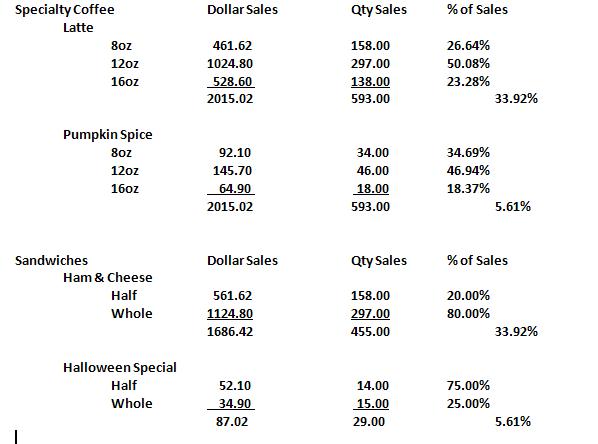
In this example we can see two main menu categories. Specialty Coffee & Sandwiches. In Specialty Coffee, Lattes account for 33.92% of all our drinks and 50.08% of those lattes were 12oz. We can see that the Halloween Special sandwich was 5.61% of our sales during this month. This report is very powerful as it let’s us see which of the items are more popular within their category.
Keep in mind that SP-1 has a number of other reports in the Business Summary that can help you. Give us a call and see what else you might want to look at!
Four tools in SP-1 for your coffee shop or restaurant manager
There are a lot of reasons to use our SP-1 point of sale in your store. We talk about ease of use, gift cards, and other features. Some of these are features that make it easy to train, track customers or just help the you, the owner, understand what is happening.
What about your manager? Well, we have some specific tools in SP-1 to help them out as well. Here are four tools in SP-1 to help your restaurant or coffee shop manager out:
1) Dashboard – this is the absolute easiest way for your manager to stay on top of the figures that matter day in and day out. Simply by selecting the Dashboard button in SP-1, your manager can see total sales, labor to sales ratios as well as direct comparisons of today vrs last week, last month and last year. This is a great way to have your manager be on top of things!
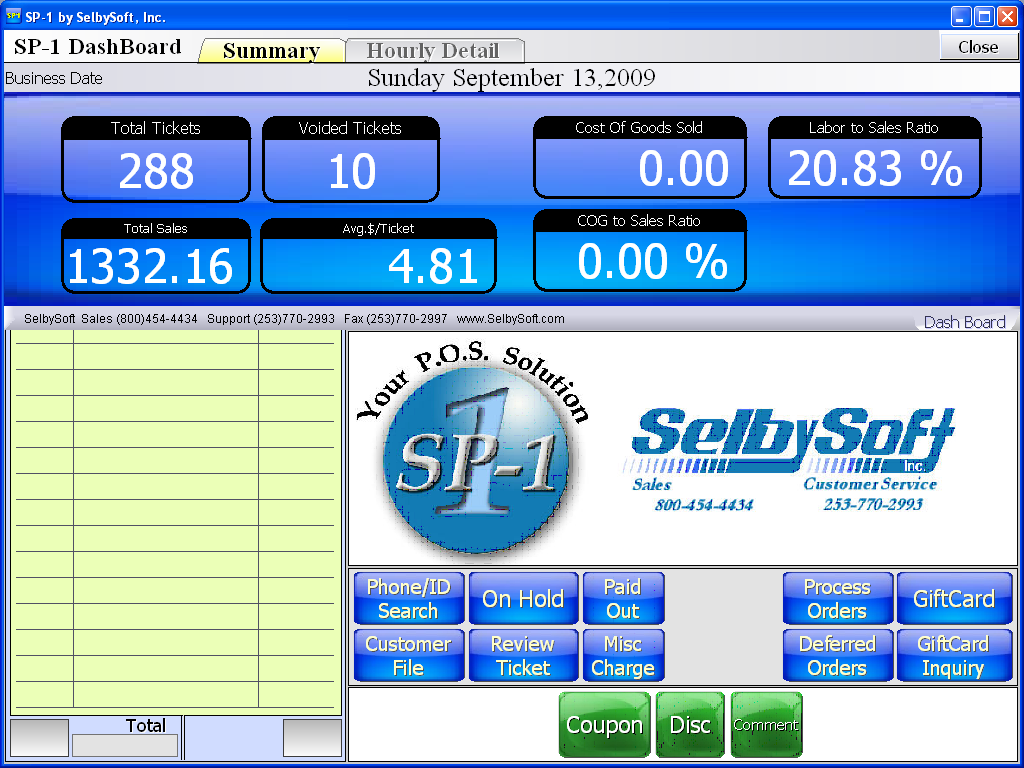
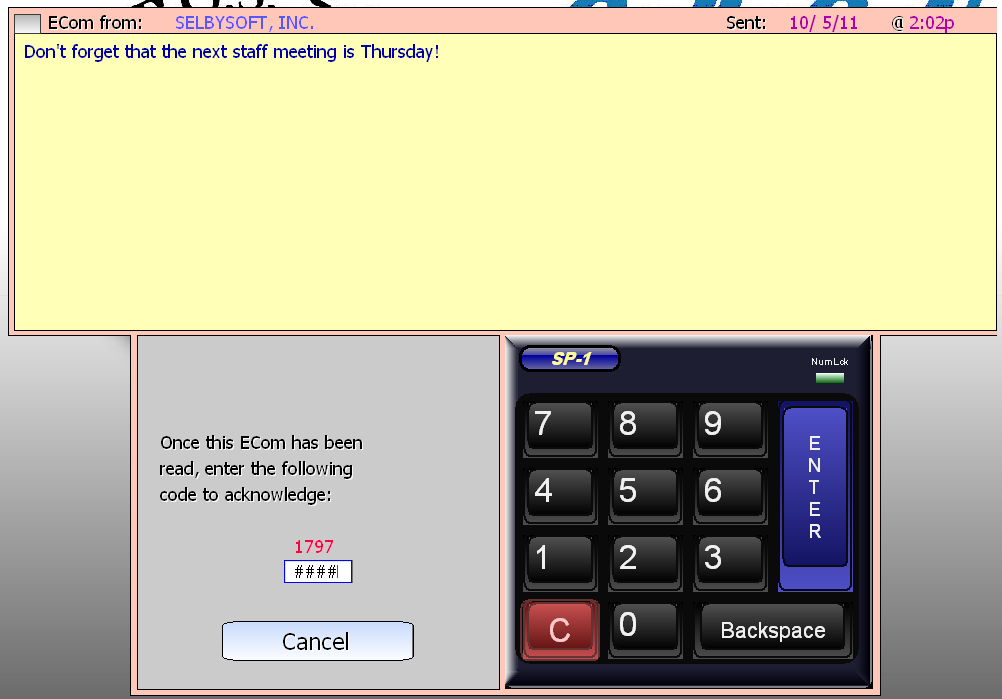
Posted in Order Entry, Reporting Tagged with: coffee shop manager, reports
How to help your coffee shop manager out!
Want to make your coffee shop manager happy? Get them a POS system. Sounds simple doesn’t it? I know, it sounds like a sales ploy to get you to buy a POS – That’s true as well. The fact is that we believe with all our heart that a POS will absolutely help you and your staff (including your manger)!
If you have taken the time to hire and groom a coffee shop manager to help manage your business, then a POS makes a lot of sense for you. Why? Because we know, through experience, that you rely on your manager to maintain the store, monitor employees and report back to you (along with dozens of other things). Without a POS system, your manager will spend part of their time focusing on putting together spreadsheets and emails so you get what you need. There is a better way.
Automate a good chuck of those tasks and allow your manager to focus on the things that are really important. Let them spend their time on coffee education, customer service, training of your staff and generally helping you make more money. With SP-1 as your POS in your coffee shop, you will see that your manager can provide the business information to you with less time wasted. Better than that is that they will have the tools available to them to monitor for themselves what is going on.
For example, your manager can see which hours are peak for sales by touching a few buttons. They can run reports to compare sales by employee to identify where training needs to be spent. You can use up sell suggestions to help not only make more money but also to open the door for customer education on differences between different coffees.
Finally, let’s not forget that YOU, the owner, have to stay on top of the manager and insure that they are doing their job right? Hourly reporting and void tracking are the best ways to do this.
Call us. See how we can help you and your coffee shop manager!
Mike.
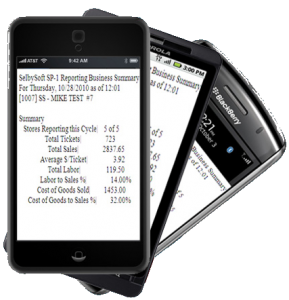
MobileDash
Posted in Employees, Marketing, POS Features, Reporting, Uncategorized Tagged with: reporting
Got Cloud? We do!
Cloud Based Backup Service. SelbySoft offers, free of charge, a cloud based backup service for every customer on an annual support plan. What this means is that we have the ability to backup all of your data, tickets, customer files to a central server outside of your store. This is a great option that allows you to be safe and have peace of mind when thinking about your data. Did we mention FREE?
P.S. We introduced this cloud based backup to our customers in 2007!
Best of Both Worlds. With SelbySoft you get the best of both worlds. Secure, controllable data storage at your site and the cloud backup. What this means is that your data is never held hostage and no internet connectivity problems will interrupt your operations at the store.
Gift Cards. You are probably aware that we have a free, built in gift card system in SP-1. This is stored locally in the POS and does not even require an internet connection to operate. Now, with the cloud backup you are secure offsite as well. Interested in cloud based gift card systems? We do it! Two different methods of having your gift card systems stored and processed out of the store. Oh and both are free!
Corporate Reporting. We can’t forget that our corporate and multi-store operators are taking advantage of our cloud based options when accessing their data from their laptop, home or corporate office!
Contact us at:
SelbySoft
Mike Spence
800-454-4434
Sales@SelbySoft.com
WWW.SelbySoft.com
8326 Woodland Ave. E
Puyallup Wa 98371
Posted in POS Features, Reporting Tagged with: backups
Back office needs?
One of the challenges that smaller stores face is that they are typically only running a single POS station at a time.
 SP-1 can certainly handle the volume and will help you increase your speed of service. But what about being able to look at numbers when the front counter is busy? What about employees clocking in?
SP-1 can certainly handle the volume and will help you increase your speed of service. But what about being able to look at numbers when the front counter is busy? What about employees clocking in?
That is where our back office license can come in. With the back office license, you can load a special version of SP-1 on a second station. This license allows you to do any of the functions of your front counter computer with the exception of taking an order.
Call us today and see how we can add this to your store!
Contact us at:
SelbySoft
Mike Spence
800-454-4434
Sales@SelbySoft.com
WWW.SelbySoft.com
8326 Woodland Ave. E
Puyallup Wa 98371
Posted in Marketing, Reporting, Uncategorized Tagged with: back office, reporting



